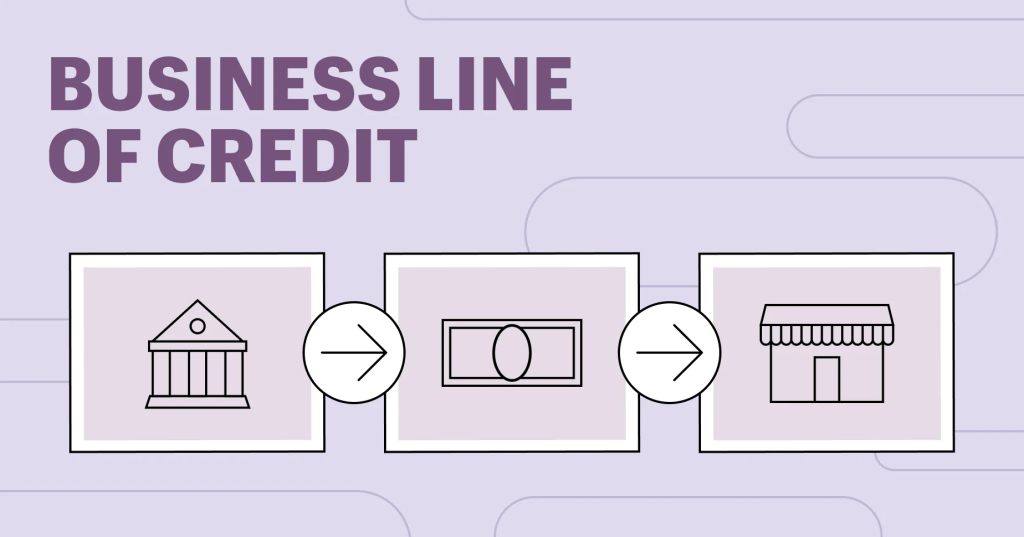A business line of credit offers a convenient solution for accessing funds when required, as opposed to receiving a one-time payment like a small business loan. It enables businesses to effectively handle their cash flow, purchase inventory, or cover unforeseen expenses.
The advantage is that you only accrue interest on the amount you utilize rather than the entire approved credit line.
The process of obtaining a business line of credit may differ from one lender to another. However, you can generally follow these steps to secure a business line of credit.
What Is a Business Line of Credit?

A business line of credit is a type of flexible credit that permits you to withdraw funds as necessary, unlike a traditional loan that is provided as a lump sum. It is ideal for effectively managing cash flow and covering ongoing expenses, allowing you to access funds up to a specified limit.
When using a business line of credit, you will only be charged interest on the amount of money you actually withdraw from the credit line. Any remaining credit that you do not use will not accumulate any interest. Similar to a business loan, a business line of credit can either be secured with collateral or unsecured.
A business line of credit is a type of financing that allows you to borrow money for your business needs over a certain period of time, typically one to five years. During this draw period, you can access funds from your line of credit as needed.
However, once the draw period comes to an end, you will enter the repayment phase, where you will be required to pay back both the initial amount borrowed (principal) and any accrued interest.
How Does a Business Line of Credit Work?

Business lenders often offer business lines of credit with slight variations in terms, but they typically consist of a draw period and a repayment period. The draw period, which typically spans two to five years, allows small business owners to borrow funds from the line of credit, up to the predetermined limit.
Throughout the drawing phase of a business line of credit, the borrowed funds will accrue interest. However, if you choose not to borrow any money, you will not be required to pay any interest. Nonetheless, there might still be a fee associated with maintaining the credit line’s availability.
During the draw period of a business line of credit, you have the option to repay the borrowed funds. However, if you choose not to repay during this period, repayment will automatically commence once the draw period ends. Once repayment starts, you will no longer have the ability to borrow additional funds on this line of credit.
When you take out a business line of credit, you will need to repay the borrowed amount in regular installments, much like a traditional business loan. It is important to note that the interest rates associated with a business line of credit can fluctuate over time.
5 Steps To Get A Business Line Of Credit
1. Decide How Much Funding You Need
When seeking a business line of credit, one must first decide on the amount of credit required. The specific loan amounts available may vary depending on the lender, but typically they range from $5,000 to $500,000.
Since interest is only charged on the amount utilized, it is acceptable to request a higher credit limit than necessary, as long as caution is exercised to avoid overspending and remaining within affordable means.
If you require additional funds beyond your original credit line, you have the option to apply for a business line of credit increase. The lender will consider factors such as your business’s revenue and credit history to determine whether to approve your request.
In some cases, they may require collateral as security for the line of credit, which could be an asset that they can take possession of in case of non-payment.
2. Check Your Eligibility
While there are several different factors that lenders consider, there are a few that are most vital, including:
- Credit history
- The evaluation of your credit history indicates the probability of you failing to repay a loan. Although many lenders typically demand a personal credit score of approximately 700, there are some lenders who may consider scores as low as 580 to 600. Nevertheless, having a higher credit score increases your chances of obtaining a loan with a lower interest rate or a larger loan amount.
- Business revenue
- When applying for a business line of credit, it is important to note that each lender has their own criteria for minimum annual or monthly business revenue. These requirements can vary greatly, with some lenders requiring a minimum of $20,000 per month, while others may require as much as $500,000 per year.
- Time in business
- Many financial institutions typically mandate that a business must have a track record of operating for a minimum of one to two years. However, certain online lenders may have more lenient requirements, only asking for six months of business operation. The longer a business has been established, the more secure it appears to potential lenders, potentially resulting in a lower interest rate being offered.
3. Research and Compare Lenders
After determining the amount of financing required and assessing your eligibility, the next step involves exploring lenders who align with your specific needs. It is crucial to compare various lenders based on factors such as their maximum credit limits, repayment terms, minimum requirements, and APR ranges.
There are a few different types of institutions that you can apply through:
- Banks and credit unions
- Business owners who have a strong credit history, established business track record, and significant annual income are usually better suited to approach traditional lenders like banks and credit unions. However, new businesses may face difficulty in qualifying for loans from these institutions.
- Online lenders
- Business owners with lower credit scores, shorter business histories, and lower business revenue can benefit from online lenders. These lenders are more likely to approve borrowers with higher risk profiles, but it’s important to note that the interest rates may be higher compared to traditional banks and credit unions.
4. Gather Required Documentation
When you have selected the lender you prefer for your business line of credit, the next step is to collect the required documents for the formal application process. These documents typically include the following:
- Business licenses
- Articles of incorporation
- Personal and business bank statements
- Personal and business tax returns
- Business plan
- Building lease
- Profit and loss statements
- Financial statements
5. Submit Your Application
Finally, you can complete your application either through an online platform or by visiting the lender’s physical location. The time it takes to receive a decision on your application may differ depending on the lender, ranging from a quick five minutes to several days.
It is possible that your lender may request additional documentation from you after they have reviewed your application.
Common information your lender may ask for includes:
- Your name
- Business name
- Social Security number (SSN)
- Desired loan amount
- Loan purpose
- Business Tax ID
- Annual revenue
Common Business Line of Credit Application Mistakes

When filling out an application for a business line of credit, it is important to be precise and accurate. Take the time to review all the numbers, contact information, and other necessary details before submitting your application. Any mistakes or errors can potentially slow down the process or decrease your likelihood of approval.
When providing your contact information, it is important to use an email address or phone number that you regularly check. This is crucial because the lender may need to reach out to you for further inquiries, and it is vital that you do not overlook any phone calls or emails.
Business Line of Credit Rates and Fees

When considering a business line of credit, it is important to be aware of the fees and penalties charged by lenders. Before submitting your application, it is advisable to compare the fees and interest rates offered by different lenders to ensure that you are obtaining the most favorable terms for your business.
Interest Rate
When you access funds from a business line of credit, you will be required to pay interest on the amount you have withdrawn. The interest rate can either be fixed or variable. A fixed rate means that it will remain constant for the duration of the loan, while a variable rate will change based on the overall market interest rate. Interest rates for business lines of credit usually fall within the range of 10% to 99%.
Draw Fee
When utilizing a business line of credit, there may be a draw fee imposed by certain lenders. This fee is applicable each time you make a withdrawal from the line of credit. The specific draw fee amount can vary depending on the lender, typically falling within the range of 1% to 2% of the withdrawn amount. To illustrate, if you were to draw $100,000 from your line of credit and the draw fee is set at 2%, the fee incurred would be $2,000.
Payment Processing Fee
If you decide to receive your business line of credit through wire transfer, there is usually a payment processing fee ranging from $15 to $35. However, you can avoid this fee by opting for standard ACH processing, although you may have to wait an additional one or two business days to receive the funds.
Late Fee
If you fail to make a payment on time for a business line of credit, the lender will typically impose a late fee. The late fee is usually calculated as a percentage of the payment amount and varies depending on the specific lender.
Termination Fee
A business line of credit usually has a specific end date. If you decide to close the line of credit before that date, you might be required to pay a termination fee, which is usually around 1% to 2% of the total loan amount. It’s worth noting that not all lenders impose a termination fee.
Prepayment Penalty
When you pay back the money you borrowed before the agreed upon time, certain lenders may impose a prepayment penalty on you. This fee typically ranges from 3% to 5% of the remaining balance. It is advisable to seek out a lender who does not impose such penalties when considering a business line of credit.
Frequently Asked Questions (FAQs)
Obtaining a business line of credit can be relatively easy if you have a strong credit score and have been in business for a minimum of two years. However, entrepreneurs who are running a startup and have lower personal credit scores may encounter challenges in securing approval for a business line of credit with favorable interest rates.
If you have a FICO credit score of 670 or higher, you have a higher chance of qualifying for a business line of credit with low interest rates. However, if your credit score is 580 or below, it may be more challenging to find a loan with favorable rates or get approved at all.
The process of acquiring a business line of credit can differ among lenders. Traditional lenders like banks often have a lengthy and thorough procedure. However, certain online lenders can provide lending decisions much faster, sometimes even within a few minutes.
A business line of credit provides businesses with greater flexibility compared to a traditional business loan. Unlike a loan, where you receive the full amount upfront and repay it over time, a line of credit allows you to access funds whenever you need them. Furthermore, you only need to pay interest on the specific amount you withdraw, regardless of the total credit line available to you.
A business line of credit is a type of financing that can be secured or unsecured. Secured lines of credit involve providing collateral, such as assets or property, which the lender can seize if the borrower is unable to repay the debt. On the other hand, unsecured lines of credit do not require any collateral. However, due to the increased risk for lenders, unsecured lines of credit usually come with higher interest rates.
There are lenders available who are willing to provide business lines of credit to new businesses. However, it’s important to note that these options may come at a higher cost and may require the business to provide collateral in order to secure the funding.





